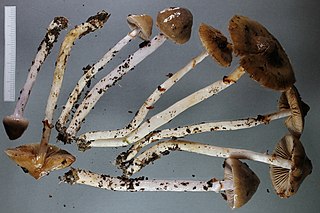Related Research Articles

The Russulaceae are a diverse family of fungi in the order Russulales, with roughly 1,900 known species and a worldwide distribution. They comprise the brittlegills and the milk-caps, well-known mushroom-forming fungi that include some edible species. These gilled mushrooms are characterised by the brittle flesh of their fruitbodies.

Lactarius is a genus of mushroom-producing, ectomycorrhizal fungi, containing several edible species. The species of the genus, commonly known as milk-caps, are characterized by the milky fluid ("latex") they exude when cut or damaged. Like the closely related genus Russula, their flesh has a distinctive brittle consistency. It is a large genus with over 500 known species, mainly distributed in the Northern hemisphere. Recently, the genus Lactifluus has been separated from Lactarius based on molecular phylogenetic evidence.

Entoloma hochstetteri, also known as the blue pinkgill, sky-blue mushroom or similar names, is a species of mushroom that is native to New Zealand. The small mushroom is a distinctive all-blue colour, while the gills have a slight reddish tint from the spores. The blue colouring of the fruit body is due to three azulene pigments. Whether Entoloma hochstetteri is poisonous or not is unknown.

Cortinarius rotundisporus, also known as the elegant blue webcap, is a basidiomycete mushroom of the genus Cortinarius found in southern Australia, where it is found in eucalypt forests and rainforests. The cap of the fruit body is a steely blue colour, with a yellowish boss, and paler similarly coloured stipe.

Cortinarius archeri is a species of mushroom in the genus Cortinarius native to Australia. The distinctive mushrooms have bright purple caps that glisten with slime, and appear in autumn in eucalypt forests.
Gigasperma is an inactive genus of fungi in the order Agaricales with a single species. It was treated either as the only genus in the monotypic family Gigaspermataceae, or part of the wider Cortinariaceae. Gigasperma was circumscribed by Austrian mycologist Egon Horak in 1971.

Lactarius sanguifluus, commonly known as the bloody milk cap, is a species of fungus in the family Russulaceae. First described from France in 1811, the species was given its current name by Elias Fries in 1838 when he transferred it to Lactarius. Found in Asia, Mediterranean Africa, and Europe, fruit bodies (mushrooms) grow scattered or in groups on the ground under conifers, especially Douglas fir. When bruised or cut, the fruit bodies ooze a blood-red to purple latex that slowly turns greenish upon exposure to air. The caps are orangish to reddish-brown, and become funnel-shaped with age. The gills are pinkish to purplish. Different forms have been described from Italy, but these are not universally accepted as distinct. L. sanguifluus mushrooms are edible, and sold in rural markets of Europe and Asia. Fruit bodies grown in polluted soil, including roadsides subject to heavy traffic, can bioaccumulate toxic heavy metals. Several sterols and pigment have been isolated and identified from the mushrooms.

Meinhard Michael Moser was an Austrian mycologist. His work principally concerned the taxonomy, chemistry, and toxicity of the gilled mushrooms (Agaricales), especially those of the genus Cortinarius, and the ecology of ectomycorrhizal relationships. His contributions to the Kleine Kryptogamenflora von Mitteleuropa series of mycological guidebooks were well regarded and widely used. In particular, his 1953 Blätter- und Bauchpilze [The Gilled and Gasteroid Fungi ], which became known as simply "Moser", saw several editions in both the original German and in translation. Other important works included a 1960 monograph on the genus Phlegmacium and a 1975 study of members of Cortinarius, Dermocybe, and Stephanopus in South America, co-authored with the mycologist Egon Horak.
Cortinarius indolicus is a basidiomycete fungus of the genus Cortinarius native to New Zealand.
Cortinarius verecundus is a basidiomycete fungus of the genus Cortinarius native to New Caledonia, where it grows under Nothofagus.
Cortinarius viscoviridis is a basidiomycete fungus of the genus Cortinarius native to New Zealand, where it grows under Nothofagus and Leptospermum scoparium.
Cortinarius aerugineoconicus is a basidiomycete fungus of the genus Cortinarius native to New Zealand, where it grows under Nothofagus.

Cortinarius salor is a basidiomycete fungus of the genus Cortinarius native to Europe and Asia, spreading as far east as Japan and New Guinea. It is also found in conifer forests of the North American Pacific Northwest.
Cortinarius microarcheri is a basidiomycete fungus of the genus Cortinarius native to South and Western Australia, where it grows under Eucalyptus.
Cortinarius taylorianus is a basidiomycete fungus of the genus Cortinarius native to New Zealand, where it grows under Nothofagus and produces an imposing purple mushroom. This species is named in honour of Grace Marie Taylor, a New Zealand fungi expert.
Cortinarius bellus is a basidiomycete fungus of the genus Cortinarius native to New Zealand, where it grows under Nothofagus and produces purple mushrooms that can grow in fairy rings.

Cortinarius cucumeris is a basidiomycete fungus of the genus Cortinarius native to New Zealand, where it grows under Nothofagus.
References
- ↑ Landcare Research NZ (2015). "EGON HORAK'S SLIDES OF NEW ZEALAND FUNGI". Fungal & Plant Disease Collection (PDD). Landcare Research New Zealand Limited. Archived from the original on 25 July 2015. Retrieved 25 July 2015.
- ↑ Petrini O, Petrini LE. "On occasion of his 60th Anniversary". Sydowia: 107–108.
- ↑ Hoch, Hannelore (26 May 2009). "Taxonomy Profile: Marianne Horak". Deutsche Entomologische Zeitschrift. 56 (1): 5–6. doi:10.1002/mmnd.200900001. ISSN 1435-1951.
- ↑ Mycobank: Horakiella
- ↑ Valenzuela E, Esteve-Raventós F (1994). "Cortinarius horakii, a new species from Chile". Mycological Research. 98 (8): 937–938. doi:10.1016/S0953-7562(09)80266-9.
- ↑ Courtecuisse R. (1984). "Notes de nomenclature concernant les hyménomycètes : sur quelques épithètes spécifiques préoccupées - 1". Documents Mycologiques (in French). 14 (54–55): 73–92.
- ↑ Raithelhuber J. (1977). Hongos Argentinos. II (in Spanish). Buenos Aires. p. 128.
- ↑ Nuytinck J, Wang XH, Verbeken A (2006). "Descriptions and taxonomy of the Asian representatives of Lactarius sect. Deliciosi" (PDF). Fungal Diversity. 22: 171–203.
- ↑ Rodríguez O, Galván-Corona A, Villalobos-Arámbula AR, Vargas G, Guzmán-Dávalos L (2009). "Pluteus horakianus, a new species based on morphological and molecular data". Sydowia. 61 (1): 39–52.
- ↑ Raithelhuber J. "Diagnoses fungorum et combinationes novae". Metrodiana Sonderheft. 4 (1): 1–22 (see p. 16).
- ↑ Gamundí IJ. "Subantarctic Geoglossaceae. II". Sydowia. 32 (1–6): 86–98.
- ↑ Guzmán G. (1978). "The species of Psilocybe known from Central and South America". Mycotaxon. 7 (2): 225–55 (see p. 244).
- ↑ Pacioni G, Lalli G. "Entità micologiche del Parco Nazionale del Circeo XIII-XV". Mic.Ital (in Italian). 13 (1): 77–81.
- ↑ Raithelhuber J. (1972). "Lateinische Kurzdiagnosen der auf der Dreiländertagung in Neubulach vorgestellten Pilzarten aus Argentinien. 2". Metrodiana (in German). 3 (1): 27–29.
- ↑ International Plant Names Index. E.Horak.